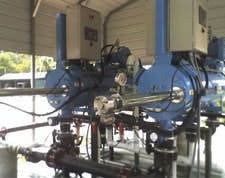Harbor Island Utilities’ 250-gal-per-minute (gpm) wastewater treatment plant has provided tertiary treatment for its 1,400-acre community in Beaufort County, S.C., for years, serving the island’s combination of year-round residents and seasonal guests. But like many states, South Carolina tightened its regulations on wastewater, pushing the small plant into a search for new treatment technology.
Microfiber Technology
Instead, Gross installed two 10-micron Amiad automatic microfiber filtration (AMF) systems. Each automatic self-cleaning unit consists of an array of small, grooved plastic cores, each wound tightly with polyester microfibers to create a highly effective filter.
When the filter has captured enough sediment and biological material to reach a set pressure differential between the inlet and outlet sides of the system, a self-cleaning cycle is engaged automatically. A high-powered stream of water is directed at each plastic core and bounced back through the microfiber by the core’s deflector plate. As it passes through the fibers, the jet stream flushes away trapped particles. Gross directs back flush water to the head of the plant, eliminating wasted water.
The system, installed in 2006, surpassed regulatory limits, delivering treated water with 0.3 parts per million (ppm) total suspended solids, <2 ppm biological oxygen demand and turbidity at or below 0.8 NTU.
“ Amiad proved to me that the technology would provide the water quality that I needed to meet the new tertiary regulations—below budget,” said Gross.
The AMF installation also features a state-of-the-art PLC controller that offers operators a full menu of monitoring and remote interface options which, along with the system’s extremely low maintenance requirements, keeps the plant running efficiently with a small staff. The filters’ compact footprint and extraordinary flexibility—they can operate at pressure ranging from 3 to 150 psi and provide filtration at the 20-, 10-, 7-, 3- and 2-micron levels—enhance their fit in a small operation.
Challenges Are Growing
Jim Lauria, vice president, sales and marketing for Amiad in Oxnard, Calif., points out that wastewater treatment plants large and small around the country are facing challenges similar to what Gross tackled.
“We’re seeing tighter specs as regulatory agencies work to clean up water supplies, and as wastewater is increasingly viewed as a resource for reuse in irrigation, grey water systems or even toilet-to-tap projects,” he says.
Lauria notes that the Amiad AMF system in its 20-micron configuration, accompanied by approved disinfection technology such as chlorine, UV or ozone, was recently approved by the State of California under its strict Title 22 wastewater discharge regulations.
He adds that prefiltration for sediment removal enhances the efficacy of technologies such as UV disinfection, in which suspended particles could create shadows or blind lenses; and membrane systems; and optimize chemical use by minimizing the amount of sediment that can bind with disinfection.
“In order for us to properly treat, conserve and recycle our most precious natural resource, we need to consider return on environment, or ROE, as well as the traditional return on investment, or ROI,” Lauria noted. “Wastewater treatment facilities are under pressure to do more than ever to make every dollar and every drop count. We clearly see plant operators in need of 21st century technology to tackle 21st century water quality challenges.”

